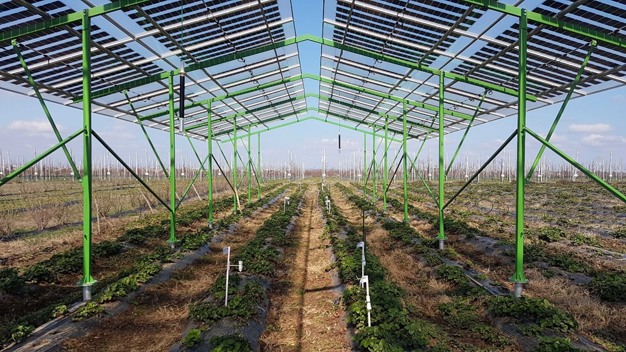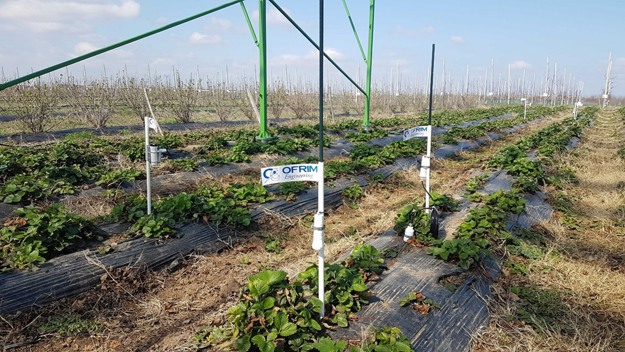The inaugural hortivoltaic systems, conceptualized and deployed by InterNET Ltd in June 2023, have been significantly upgraded by early March 2024. These enhancements include: an online monitoring subsystem powered by a comprehensive IoT sensor network and an electricity supply subsystem designed to support berry cultivation beneath semi-transparent photovoltaic panels.

This marks the first instance in Romania and Southeast Europe of a sophisticated hortivoltaic system that not only harnesses solar energy but also incorporates precision agriculture technologies for monitoring and controlling air and soil parameters. Additionally, it introduces innovative methods to enhance plant growth through the application of electric currents to both plants and soil. During the inauguration of these novel technical features within the hortivoltaic system, designed for strawberry cultivation at SCDP Baneasa in Romania, the system's technical and functional advantages were showcased to experts, as well as to representatives from media outlets, including radio and television, who were in attendance at the event.
The online monitoring subsystem developed by InterNET leverages the Aranet product suite to establish an IoT sensor network that synergizes hardware and software for comprehensive crop surveillance and communication. The Aranet IoT ecosystem, designed for industrial use, provides a flexible and wireless monitoring solution that caters to a broad range of monitoring requirements.
Featuring wireless sensors renowned for their straightforward installation, long-lasting battery life, and expansive wireless range, the system facilitates the measurement of various parameters. In the air, it measures temperature, humidity, photosynthetically active radiation (PAR), and in the soil, it gauges temperature, moisture, and electrical conductivity. These sensors relay information to base stations, which not only collect and store data wirelessly but also upload it to the cloud. Through Aranet Cloud, users gain access to this data, enabling them to monitor and analyze crop conditions remotely. The cloud service, supported by battery-powered sensors with a lifespan of up to 10 years and a communication range of up to 3 km from the base station, enhances agricultural oversight.
Moreover, the accompanying software application not only displays monitored parameter values in real-time but also provides post-processing capabilities for the gathered data. This feature delivers enriched information to farmers, supporting their daily management and decision-making processes.

The advancements in hortivoltaic systems introduced by InterNET incorporate a pioneering application of electrical engineering to the process of plant growth, embodying a concept that has garnered significant interest over the past 2-3 years: electric horticulture or electroculture. This approach offers growers a range of experimental techniques to apply continuous or alternating electric currents to both plants and soil, tailored to their specific preferences.
The pilot project explores the utilization of both direct and alternating currents at low voltages, administered via electrodes embedded in the soil or through conductive materials placed near the plant roots. The objective is to examine and contrast the effects of electric current on several key aspects: (1) the mobilization of ions and minerals within the soil, enhancing the availability of essential nutrients for plant roots; (2) the potential to boost photosynthesis—the process through which plants convert sunlight into energy; (3) the stimulation of root growth and development, leading to improved nutrient and water absorption and, consequently, healthier plant growth; (4) pest and pathogen control, potentially reducing the reliance on chemical pesticides; and (5) the mitigation of environmental stress factors, such as drought and pest invasions, by activating the plants' stress defense mechanisms.
Demonstrations and discussions
During the practical demonstrations and discussions with attendees at the event, Mr. Dragos Ofrim, PhD in Electrical Engineering and the project lead at InterNET Ltd, highlighted the strategic approach of developing and intricately integrating hortivoltaic systems. This strategy not only aims to enhance electricity production from renewable resources, primarily photovoltaic but also offers horticulture farmers—and not exclusively—a "green" aid in the micro-industrialization of farms. It paves the way for further opportunities in process automation and electromobility.
Furthermore, Mr. Ofrim pointed out, "The system showcased today marks the commencement of a collaborative research initiative with our partners in this pilot project, the Băneasa Fruit Growing Research and Development Station, focusing on electric horticulture or electroculture. This field represents a contemporary and compelling approach to plant cultivation. Through this technology, which leverages green, photovoltaic energy, we aim to achieve higher yields in the same agricultural areas, enhance the quality and health of the crops, and reduce the necessity for fertilizers and other chemical agents in the soil, thereby facilitating a greener production process."
For more information:
InterNET Ltd
21, Comana str., RO-011273, District 1,
Bucharest, Romania
Mob.: +40 744 362 378, +40 754 216 171
Email: internet@inter-net.ro, ofrim@ofrimgroup.com
www.imeon-energy.com
